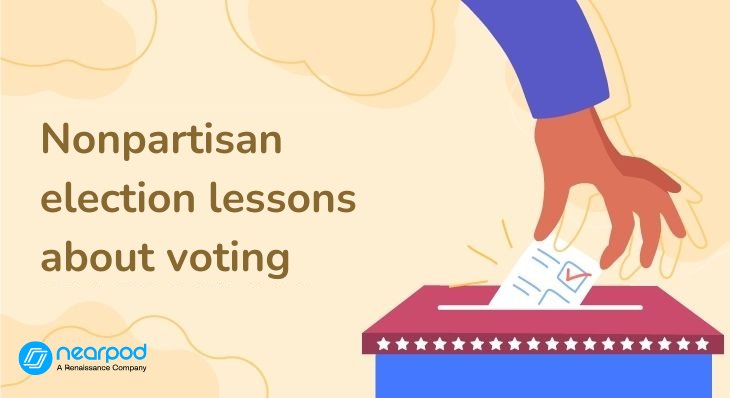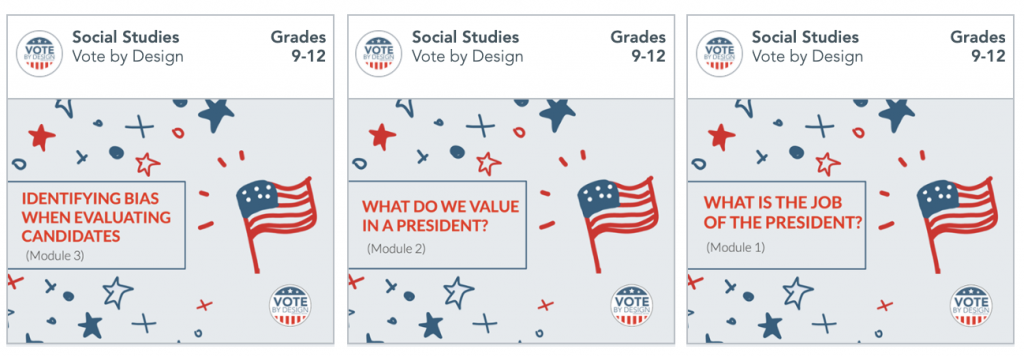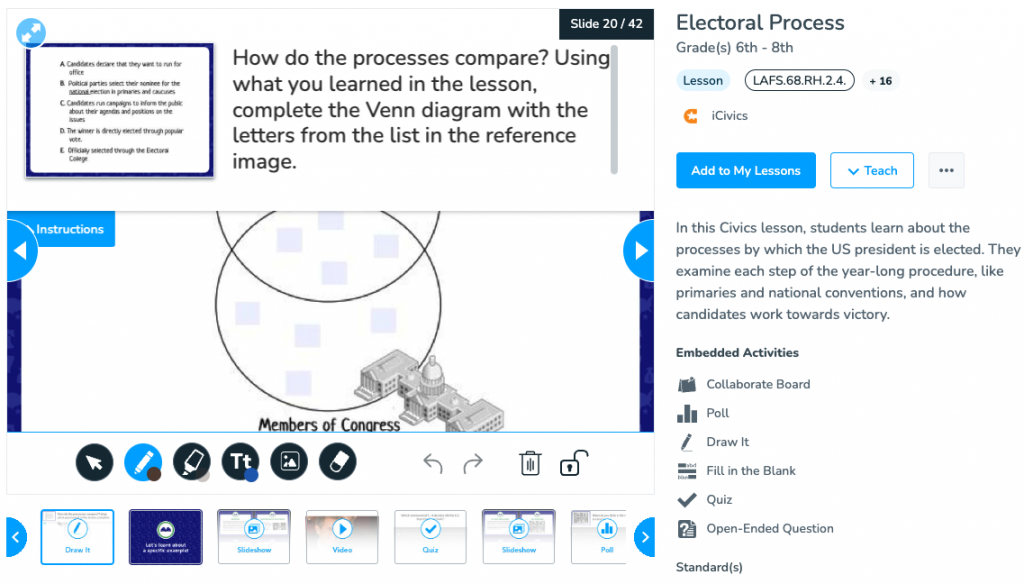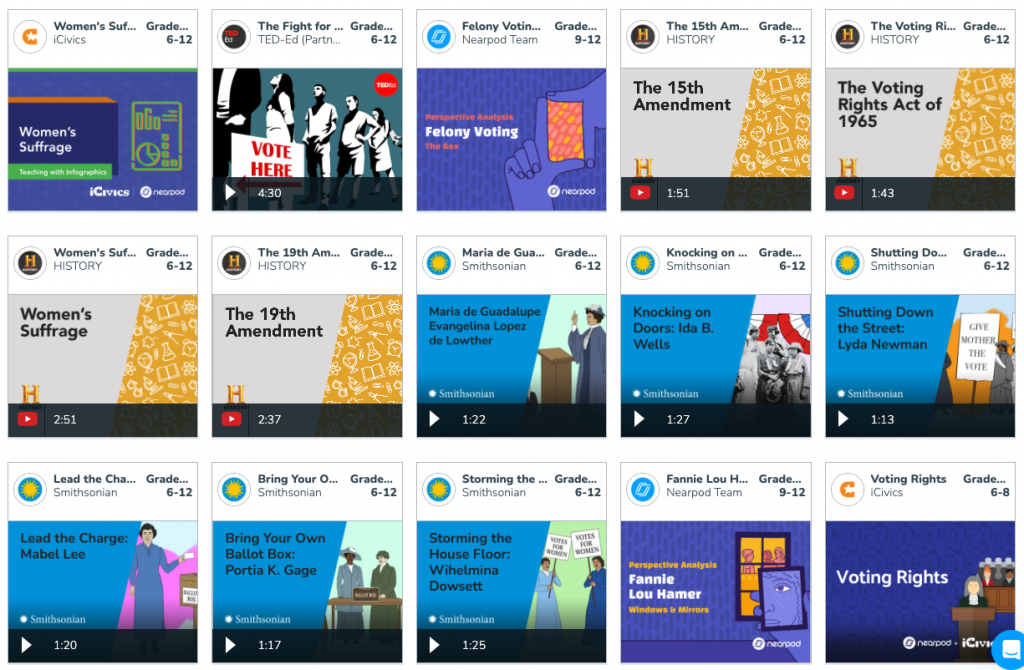
Nonpartisan election lessons and activities to teach about voting
The 2024 presidential election season is upon us. It’s important for students to understand the history, mechanics, and current events surrounding the elections so they can participate in the larger discussion. The future of our democracy will soon be in their hands. We’ve brought together a list of non-partisan election day lessons and voting activities from publishers like iCivics, Vote by Design, and more to help you discuss the election with your students. All of our materials are customizable, so you can make them your own.
Foster a love of learning in every student with Nearpod. Teachers can sign up for free below to access and create interactive lessons and activities mentioned in this article. Administrators can schedule a call with an expert to unlock the full power of Nearpod for schools and districts.
How to stay nonpartisan when teaching about election
Teaching about the 2024 presidential elections in a nonpartisan manner is essential to maintain an unbiased learning environment. Create a learning environment where students can explore the democratic process without feeling pressured to adopt a particular political stance, ultimately empowering them to become informed and engaged citizens. Here are key tips to consider:
- Stay neutral: Focus on facilitating learning, not influencing political beliefs.
- Factual information: Provide accurate, objective data on elections, candidates, and issues.
- Balance views: Present diverse perspectives to encourage critical thinking.
- Avoid bias: Recognize and set aside personal biases during teaching.
- Use reliable sources: Rely on credible sources and teach students to do the same.
- Respect opinions: Create a respectful space for students to express their views.
- Encourage critical thinking: Foster independent analysis and evidence-based conclusions.
- Establish rules: Set classroom guidelines for respectful discussions.
- Monitor discussions: Ensure discussions remain on-topic and respectful.
- Professional development: Continuously learn best practices for nonpartisan civics education.
Additionally, it’s important to utilize materials and content that are free from political bias to help maintain a fair and objective learning environment. Nearpod has nonpartisan lessons and activities for K-12 that educators can use to teach about the voting process and current events. Keep reading to explore these resources and how you can use them in the civics classroom.
Election lessons and activities to teach about the voting process
1. Build background knowledge with iCivics
The lessons you know and love from iCivics are transformed by Nearpod into an interactive experience for students. Teach about the election process, understand the power of the president, and engage students to become active participants in our constitutional democracy. Check out our comprehensive library of social studies lessons, featuring iCivics’ election-focused games.
Just to highlight a few, here are some election day lessons you can use:
- Electoral Process (Grades 6-8): In this lesson, students gain a comprehensive understanding of the U.S. presidential election process, delving into the intricacies of primaries, national conventions, and candidate strategies over the course of a year.
- Campaign Cash: Teaching with infographics (Grades 6-12): In this lesson, students explore the intricacies of campaign finance through information gathering and engaging activities, enhancing their comprehension of this crucial aspect of the political process.
- Cast Your Vote (Grades 6-12): In this game lesson, students engage in an interactive learning experience, playing a game that immerses them in the electoral process, equipping them with essential vocabulary and fostering critical thinking as they reflect on the stages of an election season.
2. Teach about the U.S. voting history
Explore the rich history of voting and elections in the United States with your students. These interactive lessons are designed to inspire and educate students about the pivotal figures and historic moments that have shaped voting rights in the nation. By using engaging content from Nearpod, teachers can effectively convey the significance of past struggles and triumphs, fostering a deeper appreciation for the democratic process among their students.
Just to highlight a few, here are some election day activities and lesson plans educators can use:
- Knocking on Doors: Ida B. Wells (Grades 6-12): In this video lesson from the Smithsonian Institution, students gain insight into the historical contributions of Ida B. Wells and the Alpha Suffrage Club, who played a pivotal role in advancing the cause of Black women’s suffrage in early 20th-century Chicago.
- Women’s Suffrage (Grades 6-12): In this iCivics lesson, students explore the women’s suffrage movement by examining two distinct approaches and tactics to secure voting rights, fostering a deeper understanding of historical advocacy for gender equality.
- Felony Voting (Grades 9-12): In this ‘The Box’ mini-lesson, students engage with a video on felony voting, critically analyzing it to discern the emphasized perspectives and those that may be underrepresented, fostering media literacy and discussions on criminal justice and voting rights.
3. Decipher democracy with lessons about the U.S. government and electoral process
Navigate the complexities of the U.S. government and electoral system with ease. These interactive lessons, videos, and educational games will help young people grasp the fundamentals of how the U.S. government operates and how elections function. With Nearpod’s engaging content, educators can empower their students with a clear understanding of the American political system, enhancing their civic knowledge and readiness for active participation in the democratic process.
Just to highlight a few, here are some election process lessons educators can use:
- Political Parties (Grades 6-8): In this one-minute video lesson, students explore the concept of political parties, learn about the historical origins of Democrats and Republicans, and engage in discussions on the pros and cons of these political groups.
- Congressional Elections (Grades 6-12): In this Crash Course video lesson, students delve into the significance of congressional elections, providing an engaging resource for classroom discussions on the electoral process and its role in shaping government.
- Redistricting & Gerrymandering (Grades 6-Higher Ed): In this current events lesson, students gain insight into the significance of the U.S. Census, the concept of redistricting, and the potential impacts of gerrymandering.
4. Stay up-to-date with current events lessons
Incorporating current events during the elections into your instruction helps students connect with real-world issues and understand their impact. Making lessons relevant and engaging through current events is key, however, it’s also crucial to teach kids media literacy skills. This empowers students to critically evaluate news, assess source credibility, spot bias, and grasp the broader context.
Nearpod creates timely current events lessons on newsworthy topics, making it easier to keep students informed about significant milestones. Our collection of current events lessons synthesizes major events through engaging media and interactive activities. These lessons not only inform students but also incorporate media literacy principles to help them navigate today’s complex media landscape effectively.
Consider exploring our media literacy lessons to have students practice applying these skills to current events. In this Nearpod digital citizenship lesson called Sourcing Your Information, 6-8th grade students identify strategies for determining who creates information online, as well as learn about credibility, conflict of interest, native advertising, and how to fact check.
5. Inspire ownership in the next generation of voters with Vote by Design
Maybe you’re confident in your students’ knowledge of the electoral process but struggling to ignite excitement. Look no further! Vote by Design is a non-partisan learning experience designed to promote civic engagement and agency among all voters. Their interactive mini-lessons for grades 9-12 use a design-thinking and student-centered approach to help next-gen voters determine which leadership qualities are most important to them and why.
Use these module lessons in your civics classroom:
- What is the Job of the President? (Module 1): This lesson is designed to encourage civic engagement and facilitate a personal understanding of the U.S. President’s role and the key considerations when choosing a candidate to vote for.
- What Do We Value in a President? (Module 2): In this lesson, students will assess the historical experiences, leadership qualities, and personal attributes that contribute to effective presidential leadership.
- Identifying Bias When Evaluating Candidates (Module 3): In this lesson, students use active and critical listening skills during presidential debates, enhancing their ability to make informed judgments about presidential candidates and their policies.

6. Bring the election into any lesson across all subjects
The election is relevant across all subjects, not just civics. Consider framing lessons around the elections to help students connect classroom learning to the real world and foster a well-rounded education that prepares them to be informed, engaged, and responsible citizens.
Here are some ideas educators can use on election day for kids:
- Math: Have students calculate votes through an electoral college activity. The president will need 270 votes to win. What are the different paths to get there? You could also look at the math that determines the electoral votes your state has.
- English Language Arts (ELA): Have students write argumentative essays about topics central to this year’s election. Have them research the sides of the issue and construct their own argument based on facts.
- Science: Have students research candidates’ stances on issues such as climate change, renewable energy, or conservation. Have them write argumentative essays about these topics that are relevant to the current election.
7. Help students process their emotions after the elections
Give students the space, tools, and platform to process their feelings after election day. Allow them to practice self-awareness by identifying and expressing different emotions. These Nearpod social and emotional learning activities (SEL) activities are designed to help students recognize different feelings and emotions with direct instruction and modeling, frequent checks for understanding, authentic group practice, and reflection exercises. Students will also learn to develop self-management by managing stress and controlling impulses through mindfulness.

Start using election day resources
As we gear up for teaching the 2024 election, educators have a unique opportunity to engage students with meaningful, nonpartisan lessons about the democratic process. By incorporating these lessons and fun activities like mock elections, teachers can empower the next generation of voters to become informed and active participants in our democracy. With Nearpod’s customizable election-related resources, you’ll have the tools to teach students about voting, government, and current events in an engaging, unbiased way.
Foster a love of learning in every student with Nearpod. Teachers can sign up for free below to access and create interactive lessons and activities mentioned in this article. Administrators can schedule a call with an expert to unlock the full power of Nearpod for schools and districts.

Adam is a Learning Experience Designer at Nearpod. He previously taught High School History teacher in Houston, Texas where he also served as the Social Studies Department Chair. Adam is currently in charge of the quality control of Nearpod’s learning experiences. He is also the manager of the Digital Citizenship and Literacy program.




